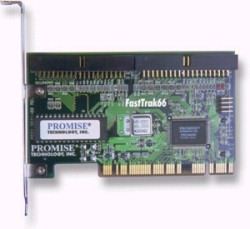| Fast Trak 66
by John Reynolds |
||||
|
When it comes to upgrading a computer, I suspect few people think of their hard drives first, giving instead priority to the latest Intel or AMD processor, or consideration to that new Nvidia or 3dfx accelerator. They might even add more system memory before a new hard drive enters into the upgrade picture, unless they're suddenly finding themselves running extremely low on storage space. Yet like the components mentioned above, hard drive technology for both IDE and SCSI devices has been inexorably improving, and perhaps it's time to give some thought to upgrading your storage devices. The latest in fixed drive wizardry is Promise Technology's Fast Trak66, an PCI-based IDE RAID controller card that supports Ultra ATA/66 modes of data transfer. Last year saw the release of the original Fast Trak, which was limited to its support of ATA/33, and Promise hopes to have a winner with its new card. Hard drives can be easily divided into two main categories, IDE and SCSI, with the former being the most common type of drive throughout the home PC market. Yet SCSI drives have always held a performance lead against their less expensive siblings, and here's where Promise expects to market its new RAID card: improved IDE performance. To those unfamiliar with the acronym, RAID stands for Redundant Array of Independent Disks, and there are two means by which the various levels of RAID may be implemented: hardware or software. Certain operating systems such as Widows NT offer software striping, but most RAID setups are created through the use of a hardware controller such as the Fast Trak66. RAID allows for several drives to be merged, or striped, into a single partition or for a single drive's contents to be copied, or mirrored, onto another. Striping is known as RAID 0 and mirroring as RAID 1. There are other, more powerful, forms of RAID, yet for the purposes of this review I'll be dealing primarily with RAID 0, or striping. The Fast Trak66 offers not only both of these forms of RAID (0 and 1) but also 1+0, which requires a total of 4 hard drives, two of which are striped into a single drive, the contents of which is then mirrored onto the remaining two. Four drives is the maximum the Fast Trak66 handles, as that it sports two separate IDE controllers, much like a standard motherboard. And if two drives are cabled to a single controller one must be jumpered as the master and the other slave, same as with onboard IDE. |
 Yet the Promise card will work in conjunction with your motherboard's controller, allowing for up to eight IDE devices in a single computer, though the RAID card itself is limited to only hard drives-no ATAPI devices can be used with the Fast Trak. Having recently reviewed Western Digital's superb Expert hard drive, I decided to use two of these in a RAID 0 array for maximum IDE performance. It's best to use identical drives with the Fast Trak66, since a striped array can only build upon the performance of the slowest drive. Moreover, the array can only be twice the size of the smallest drive used, either striped or mirrored. In this case, I created a single, 18gb volume with the two Expert drives, both configured to run in ATA/66 mode. Just pop the Fast Trak66 into an empty PCI slot, use the two ribbon cables provided in the box to cable the drives you're using to the card itself, which is built on a remarkably small PCB, and power up. Building the array you want is fairly straightforward and easy to understand, thanks to Promise's excellent documentation. Upon bootup, the Fast Trak's BIOS will tell you there are no arrays defined and to hit CTRL-F on your keyboard to enter into its setup options, called the FastBuild utility. At the top of the main menu is the Auto Setup option, which quickly allows you to choose the Performance option for RAID 0 (striping) or Capacity for RAID 1 (mirroring). I chose Performance, and under Typical Application Usage I went with A/V Editing, which sets the stripe size to 64k. This larger stripe set, or block, allows for better performance as it's the point at which the controller divides the information it writes to the array. Smaller stripe sets require more overhead management from the controller, which subsequently results in higher CPU utilization-not a good thing. I didn't experience any problems while creating this striped array, but I wasn't using the motherboard's onboard IDE controllers either, save for the CD-ROM drive. However, if you plan on using hard drives on both the onboard controller and the Fast Trak66, the motherboard must support the "Boot to SCSI" option in its BIOS to be able to boot from the card. Otherwise, the boot disk must be cabled to the motherboard. Go to Page Two
|
|||
|
Copyright © 1997 - 2000 COMBATSIM.COM, INC. All Rights Reserved. Last Updated July 8th, 1999 |
||||
